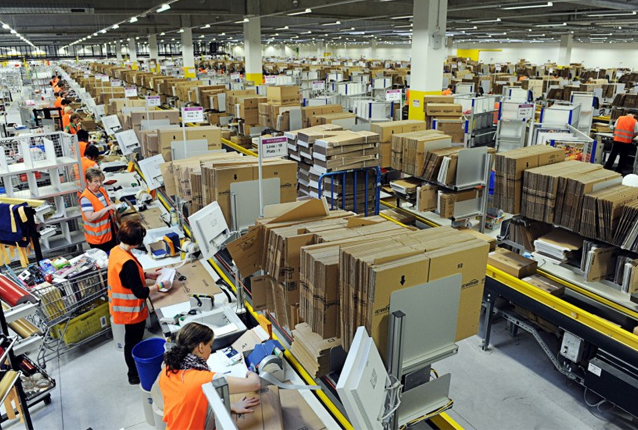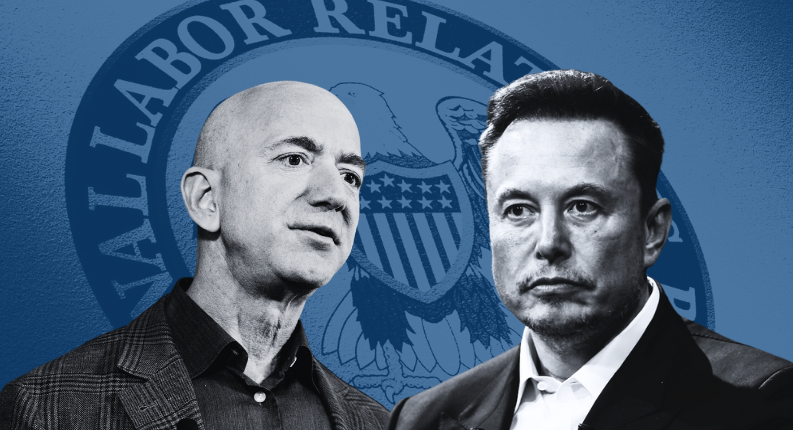Stacy Mitchell is co-director at the Institute for Local Self-Reliance (ILSR), and Olivia LaVecchia is a research associate with its Community-Scaled Economy initiative. Together they co-authored ILSR’s report: “Amazon’s Stranglehold: How Amazon’s Tightening Grip on the Economy Is Stifling Competition, Eroding Jobs, and Threatening Communities.” This week, ILSR and Jobs With Justice partnered to produce a fact sheet that looks at how Amazon undermines working people.
Amazon increasingly dominates the retail industry. The company now captures nearly one in every two dollars that Americans spend online. It sells more books and toys, and – by later this year – apparel and consumer electronics, than any other retailer, online or off. It’s also rapidly expanding into the grocery business.
How has Amazon become such a giant? How does it keep prices low and ship packages fast, while making its founder and CEO Jeff Bezos the planet’s fifth-wealthiest person, with an estimated net worth of $65 billion? Amazon undercuts communities and hundreds of thousands of women and men who work in its warehouses and deliver goods to our doorsteps.
Amazon employees report grueling workdays in its vast network of windowless warehouses. People who work in these warehouses complain of racing across distances equal to multiple football fields, frequent bending and squatting, and having to reach production quotas up to 60 percent above the industry standard. “The worst part was getting on my hands and knees 250 to 300 times a day,” a man working as a picker in a Pennsylvania warehouse told The Morning Call. He added that he was expected to pick 1,200 items in a 10-hour shift, which involved fishing items out of bins near the floor. “It’s actually impossible to meet the productivity standards and do so safely,” said Beth Gutelius, a researcher who has studied Amazon.
Despite these demands and risks, Amazon treats its employees as if they’re expendable. Roughly 40 percent of the people working in Amazon warehouses are temporary employees who lack job benefits and security. Although Amazon refers to these positions as “seasonal,” it relies on temporary employees year-round and hires many of them through staffing agencies. By not hiring people directly, Amazon skirts liability for any on-the-job injuries or mistreatment.
Amazon’s regular, direct hires aren’t much better off. In 11 metro areas where Amazon has warehouses, it pays an average of 15 percent less than the prevailing local wage for comparable warehouse work. In Atlanta for instance, where Amazon has three large facilities, wages are 19 percent lower than the prevailing warehouse wage, and 29 percent below the living wage for the region.
Most Amazon orders are still delivered by UPS and the U.S. Postal Service, but that’s rapidly changing. Amazon is taking over more of its own package delivery, using an Uber-like app to manage freelance drivers. It’s also turning to low-cost regional couriers that classify their drivers as “independent contractors” instead of employees. Amazon’s regional couriers require drivers to pay out-of-pocket for fuel and insurance. As a result, drivers at times earn less than minimum wage, according to drivers in California and Arizona who recently filed suit against Amazon to gain status as direct employees.
Amazon is often praised as a job creator, innovator, and economic leader. However, the dirty secret behind Amazon’s growth is that as it displaces sales at other businesses, it in fact destroys more jobs than it creates. Amazon employed 146,000 working people in the U.S. at the end of 2015, but at a cost 295,000 jobs at other retail businesses. It has forced small independent retailers out of business through its predatory practices. And as both these local stores and major chains close their doors, communities lose a critical source of property and sales tax revenue.
Local and state governments have provided more than $600 million in incentives to Amazon to subsidize its expansion. There’s no excuse for using taxpayer funds to roll out the red carpet for a corporation that benefits from creating unsustainable jobs. To make sure the economy works for everyone, public officials and communities must rewrite the rules to stand up to Amazon.





